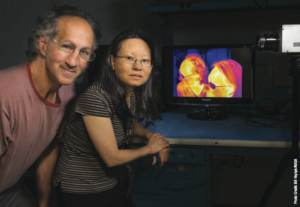
Under the study funded by NASA’s Earth Science Technology Office, or ESTO, a Goddard team will define a mission architecture in which multiple Capsulation Satellites, or CapSats, would be outfitted with the so-called Strained-Layer Superlattice Infrared Detector Camera, also known as SLS (see related story: “Goddard Develops Satellite Concept to Exploit Rideshare Opportunities”).
“The CapSat concept can be very powerful when used in distributed architectures, such as flying multiple instruments on a constellation of CapSats,” said Azita Valinia, the ESTO executive who funded the study. “In this study, SLS detectors are used for land-imaging applications, but the constellation architecture can be applied to both Earth and space science measurement scenarios.”
Valinia chose SLS for the study because it’s already far along in its development and appears to be a good fit for a potential CapSat mission. “ESTO previously funded several detector projects, in addition to the recent SLS detector development, as part the of the Sustained Land Imaging Technology study portfolio. It shows possible potential for future land-imaging applications,” said George Komar, ESTO director.
Detector Improvements
SLS is the next-generation of a previous infrared camera system based on the Quantum Well Infrared Photodetector, or QWIP, technology. Goddard technologist Murzy Jhabvala spent nearly two decades refining QWIP technology before NASA selected it for use on Landsat 8’s Thermal Infrared Sensor, or TIRS (see Goddard Tech Trends, Summer 2010, Page 6). TIRS now is monitoring the ebb and flow of land-surface moisture levels and the health of vegetation—data that western states use to monitor water consumption.
Since Landsat 8’s launch, Jhabvala and his industry partner, QmagiQ, a Nashua, New Hampshire-based company, have further improved the large-format SLS detector technology.
Like its QWIP predecessor, SLS is a band gap-engineered detector. Detector arrays are fabricated on a gallium-antimonide semiconductor wafer coated with alternating epitaxial layers of gallium antimonide, indium arsenide, and indium antimonide, repeated more than 600 times. The very thin layers absorb infrared photons and convert them to electrons—the fundamental particles that carry an electric current—and only light with a specific energy, or wavelength, can release them.
Infrared radiation with the correct energy is absorbed in the SLS structure, which releases an electron that a silicon-readout chip directly mated to the SLS detector array then collects. The readout chip converts the electron to a voltage that corresponds to the incident signal and a computer then uses this information to recreate an image of the infrared source. Detector developers can vary the composition and thickness of the layers to tune the detector’s sensitivity to specific wavelength bands.
Compared with its QWIP predecessor, SLS detectors are more than 10 times more sensitive, can operate at warmer temperatures, and exhibit a wider range of spectral selectivity, among other things, said Jhabvala, adding that the technology, like QWIP, is relatively inexpensive to build.
First Flight Demonstration
Jhabvala and his team will have a chance to demonstrate SLS when they fly an experimental unit on NASA’s next Robotic Refueling Mission. Scheduled for 2017, the mission will advance and demonstrate the capability to service and refuel satellites on orbit. “If we get just one image of Earth, we will have been successful. Of course, we hope to collect many more than just one image,” Jhabvala said. “We want to prove that this technology is spaceflight worthy.”
In the meantime, as part of the ESTO study due this fall, he and CapSat developer Joe Burt are studying the viability of launching the photodetector technology on a handful of CapSats.
“What we wanted to do was to perform a quick concept definition and feasibility study, leveraging already-funded detectors that are a good fit for the spacecraft,” Valinia said. “If the concept is determined viable—and that is my hope by funding this study—then plans can be made to secure funding to fly such a constellation tailored to specific science or commercial applications.”






